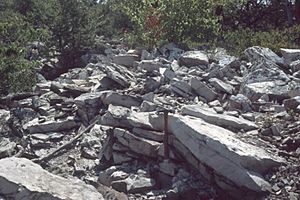Tuscarora Sandstone facts for kids
Quick facts for kids Tuscarora FormationStratigraphic range: Aeronian - Telychian |
|
|---|---|

Outcrop of Tuscarora Formation in Thickhead Wild Area, Centre County, Pennsylvania
|
|
| Type | sedimentary |
| Sub-units | Castanea Member |
| Underlies | Clinton Group and Rose Hill Formation |
| Overlies | Juniata Formation |
| Lithology | |
| Primary | quartzarenite (sandstone) |
| Other | conglomerate |
| Location | |
| Region | Appalachian Mountains |
| Extent | Maryland, Pennsylvania, Virginia, and West Virginia |
| Type section | |
| Named for | Tuscarora Mountain |
| Named by | Darton and Taff |
The Tuscarora Formation is a special type of rock found in the eastern United States. It is also known as Tuscarora Sandstone or Tuscarora Quartzite. This rock unit is mainly found in the states of Pennsylvania, Maryland, West Virginia, and Virginia. It formed during the Silurian period, which was about 440 to 417 million years ago.
Contents
What is the Tuscarora Formation?
The Tuscarora Formation is a very hard rock. It is mostly a type of quartzite, which is like super-hard sandstone. You can find it in different colors, like white, gray, or gray-green. Sometimes, it also contains small pebbles, making it a conglomerate. It can also have thin layers of shale and siltstone.
This rock is very strong. That's why it forms the tall ridges you see in the Ridge-and-Valley Appalachians. These mountains are in the eastern part of the United States. In Pennsylvania, the Tuscarora Formation can be about 935 feet (285 meters) thick. In Maryland, its thickness changes from 60 feet (18 meters) to 400 feet (122 meters).
Where can you see the Tuscarora Formation?
You can often see the Tuscarora Formation on the tops of ridges. It is also visible where rivers cut through mountains. These cuts are called water gaps. You can find many great examples in Pennsylvania, Maryland, and West Virginia.
For example, in Pennsylvania, you can see it along US 30 in Bedford County. It's also clear at Jack's Narrows, where the Juniata River flows through Jack's Mountain. Many of the "Thousand Steps" on the Standing Stone Trail are made of this rock.
In Maryland, US 40 goes through the Cumberland Narrows. Here, you can see arched rock outcrops of Tuscarora sandstone.
In West Virginia, the River Knobs have amazing, almost straight-up cliffs of Tuscarora sandstone. Famous spots like Seneca Rocks, Champe Rocks, Judy Rocks, and Nelson Rocks are all made of this rock. You can see these cliffs from U.S. Route 33 and West Virginia Routes 28 and 55. North Fork Mountain is another long ridge topped by Tuscarora sandstone.
There are also two large quarries on Canoe Mountain where you can see a lot of the Tuscarora Formation.
Where is the Tuscarora Formation found?
The Tuscarora Formation is found across several states in the USA. These include Pennsylvania, Maryland, West Virginia, and Virginia.
How does the Tuscarora Formation fit with other rocks?
The Tuscarora Formation sits on top of the Juniata Formation. It is found below the Clinton Group in Pennsylvania. Geologists say these layers fit together perfectly.
The Tuscarora Formation is similar to other rock layers found nearby. These include the Minsi and Weiders members of the Shawangunk Formation in eastern Pennsylvania, New Jersey, and New York. It's also like the Massanutten Formation in Virginia. Further south, it's called the Clinch Sandstone.
The Tuscarora Formation has one special part called the Castanea Member. This part is found at the very top of the formation.
What fossils are found in the Tuscarora Formation?
Not many fossils are found in the Tuscarora Formation. Most of the fossils are trace fossils. These are not the actual remains of animals. Instead, they are signs of animal activity, like tracks or burrows.
Scientists have found at least two types of ancient sea scorpions, called Eurypterids, in the Tuscarora Formation.
How old is the Tuscarora Formation?
The Tuscarora Formation was formed during the early Silurian period. This means it was deposited between 440 and 417 million years ago.
How is the Tuscarora Formation used?
The Tuscarora Formation has been useful to people. In the 1800s, it might have been used to make special linings for furnaces. These furnaces were used to melt iron.
Today, the Tuscarora Formation is very important for tourism. Its dramatic cliffs and ridges in eastern West Virginia attract many visitors. You can see these amazing rock formations from roads like U.S. Routes 33 and 50, and West Virginia Routes 28 and 55. Places like Spruce Knob and Dolly Sods offer great views of these Tuscarora-capped mountains.
Seneca Rocks in Pendleton County, West Virginia, is a world-famous spot for rock climbing. It's the only "true peak" on the East Coast. This means you need special climbing skills to reach its top. Two climbing schools and many guides offer trips on its more than 300 climbing routes. The U.S. Forest Service manages Seneca Rocks. It is part of the Spruce Knob-Seneca Rocks National Recreation Area.
The Nelson Rocks Preserve is another special place. It's a private nature preserve near Circleville, West Virginia. It helps protect Nelson Rocks and the area around it. This preserve has a via ferrata climbing trail, which is a climbing path with fixed cables and ladders. It is one of only a few in the United States.
Images for kids
-
The white Tuscarora Formation (left) on top of the red Juniata Formation (right) at the Narrows in Bedford County, Pennsylvania.
-
A sample of Tuscarora Formation rock showing a Diplocraterion trace fossil. This specimen is about 22 cm tall.
-
Seneca Rocks, a dramatic Tuscarora sandstone outcrop in West Virginia. (Wood engraving by David H.Strother, 1872)





